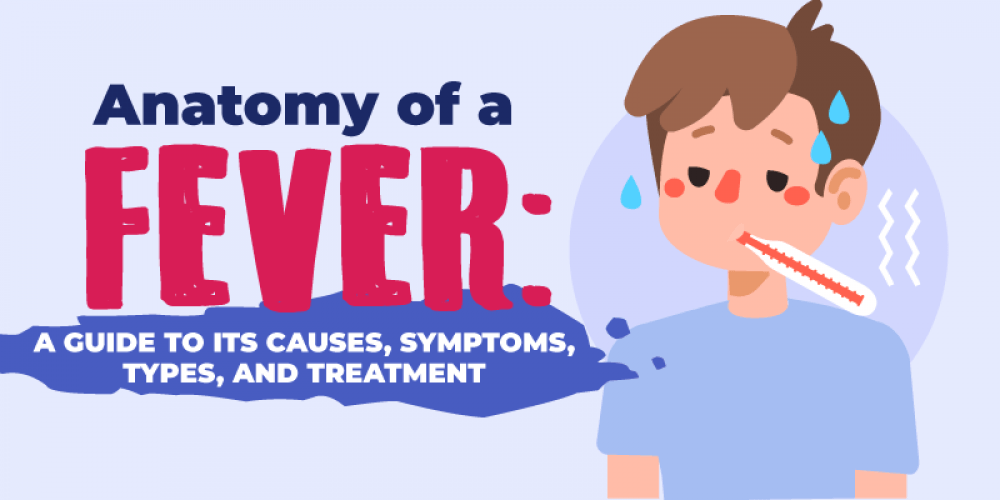Chances are you have probably had a fever at least once—high body temperature, fatigue, and chills indicating something wrong inside your body. Also, while children may be more prone to them, adults can still contract them, albeit at a lower likelihood due to their more efficient immune systems.
The infographic below can help you understand the fundamentals of fevers—their causes, symptoms, and treatments. However, before we proceed, it is essential to realize that unfounded beliefs often undermine people’s efforts to manage this condition. So, let us separate fact from fiction to understand fevers better.
What are Fevers?
Fevers involve a temporary rise in your body temperature. It indicates that your immune system responds to an infection, illness, or other conditions. Contrary to popular belief, fevers are not an illness; it is your immune system’s natural way of restoring balance within your body.
Are you wondering why your body becomes hot during fevers? The “normal” body temperature varies slightly among individuals. However, it generally sits at around 98°F for adults and somewhat higher among babies and toddlers. When your body detects an infection, it releases pyrogens to interact with your hypothalamus. Then, the hypothalamus raises your body temperature, inducing a fever.
Fevers: Fact vs. Fiction
Fevers have been a subject of fascination and concern for millennia, leading to various beliefs surrounding their nature. Discerning unfounded thoughts surrounding fevers is crucial to managing and treating them effectively.
Myth #1: All fevers are dangerous and require immediate medical intervention.
Fevers are your body’s natural response against intruders, so they are not inherently dangerous. They indicate that your immune system is healthy and capable enough to fight infections and illnesses. You only need to let the fever run its course to recover.
However, not all fevers are good. The following circumstances may warrant immediate medical attention:
- Prolonged fevers
- Very high body temperature (103°F or higher)
- Accompanying symptoms, including loss of consciousness, seizures, breathing troubles, and confusion
- Medical conditions, such as COVID-19, pneumonia, and infected wounds
Myth #2: You should always use antipyretic medicine to treat fevers.
Again, fevers are a part of your body’s natural defense mechanism. Antipyretic medicines can help manage discomfort from fevers but are not necessary treatments. Some people even advocate letting a fever run without medications since it is the natural way to defend against illnesses and infections.
Alternatively, consider addressing what your fever is responding to. For instance, if you suspect an infected wound is causing it, you could prioritize healing the injury properly to relieve your symptoms. That said, consult a healthcare professional before administering any treatment for fever.
Myth #3: Sponge baths with cool water can reduce a fever.
Sponge baths with cool water were a common practice to reduce body temperature. Its practitioners believe it relieves chills and fatigue, making the sick more comfortable. However, this practice is now obsolete. Cold water or alcohol-based sponge baths can increase body temperature by stimulating heat production, exacerbating shivers and chills.
Instead, focus on maintaining a comfortable environment. Dress lightly and stay hydrated to avoid overheating. If you need to clean your body with a sponge, use warm or lukewarm water to prevent increasing body heat. However, consult a healthcare professional if your fever persists for over a week or reaches 103°F or higher.
Myth #4: Fevers hinder the body’s recovery from illnesses.
Indeed, fevers cause discomfort and fatigue that may make you feel like you are not recovering. However, they are beneficial to your healing process. Your body’s elevated temperature boosts infection-fighting cells and antibodies, enhancing your immune system’s response.
Also, some studies suggest that high temperatures from fever slow down viral replication, giving you a better chance at fighting viruses.
The Causes, Symptoms, and Treatment of Fevers
Since fever has concerned people for millennia, unfounded beliefs from the past have been undermining everyone’s efforts to treat it until today.
So, try to separate myths from truths to understand fever’s implications for your health and well-being. Also, consult a healthcare professional for accurate and science-based advice and guidance if you have any questions or concerns. You can help your body fight infections and illnesses to enjoy a healthier life.
Are you interested in learning more? The infographic below delves into fevers and their causes, symptoms, and treatment to help you understand them better.



